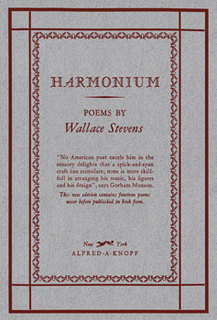Related Research Articles

Harmonium is a book of poetry by American poet Wallace Stevens. His first book at the age of forty-four, it was published in 1923 by Knopf in an edition of 1500 copies. This collection comprises 85 poems, ranging in length from just a few lines to several hundred. Harmonium was reissued in 1931 with three poems omitted and fourteen new poems added.
"The Paltry Nude Starts on a Spring Voyage" is a poem from Wallace Stevens's first book, Harmonium. Originally published in 1919, it is in the public domain. Despite general agreement that it is indebted to Botticelli's The Birth of Venus, there is uncertainty about the nature of the debt.
"Le Monocle de Mon Oncle" is a poem from Wallace Stevens's first book of poetry, Harmonium. It was first published in 1918.
"Metaphors of a Magnifico" is a poem from Wallace Stevens's first book of poetry, Harmonium (1923). It was first published in 1918, so it is in the public domain. The poem experiments with perspective.
"Ploughing on Sunday" is a poem from Wallace Stevens's first book of poetry, Harmonium (1923). First published in 1919, it is now in the public domain.
"Hibiscus on the Sleeping Shores" is a poem from Wallace Stevens's first book of poetry, Harmonium. It was first published in 1921 and is therefore in the public domain.
"O Florida, Venereal Soil" is a poem from Wallace Stevens's first book of poetry, Harmonium. It was first published in the journal Dial, volume 73, July 1922, and is therefore in the public domain.
"Of the Surface of Things" is a poem from Wallace Stevens's first book of poetry, Harmonium (1923). It was first published in 1919, so it is in the public domain.
"Sunday Morning" is a poem from Wallace Stevens' first book of poetry, Harmonium. Published in part in the November 1915 issue of Poetry, then in full in 1923 in Harmonium, it is now in the public domain. The first published version can be read at the Poetry web site: The literary critic Yvor Winters considered "Sunday Morning" "the greatest American poem of the twentieth century and... certainly one of the greatest contemplative poems in English".
"Banal Sojourn" is a poem from Wallace Stevens's first book of poetry, Harmonium. It was originally published in 1919, therefore it is in the public domain.
"Stars at Tallapoosa" is a poem from Wallace Stevens's first book of poetry, Harmonium. It was first published in 1922, so it is in the public domain.
"Six Significant Landscapes" is a poem from Wallace Stevens's first book of poetry, Harmonium. It was first published in 1916, so it is in the public domain.
"Anecdote of the Jar" is a poem from Wallace Stevens's first book of poetry, Harmonium. First published in 1919, it is in the public domain.
"Palace of the Babies" is a poem from Wallace Stevens's first book of poetry, Harmonium. It was first published in 1916 and is therefore in the public domain.
"Life is Motion" is a poem from Wallace Stevens's first book of poetry, Harmonium. It was first published in 1919, so it is in the public domain.
"Thirteen Ways of Looking at a Blackbird" is a poem from Wallace Stevens's first book of poetry, Harmonium. The poem consists of thirteen short, separate sections, each of which mentions blackbirds in some way. Although inspired by haiku, none of the sections meets the traditional definition of haiku. It was first published in October 1917 by Alfred Kreymborg in Others: An Anthology of the New Verse and two months later in the December issue of Others: A Magazine of the New Verse.
"Theory" is a poem from Wallace Stevens's first book of poetry, Harmonium. It was first published in 1917, so it is in the public domain.
"The Man Whose Pharynx Was Bad" is a poem from Wallace Stevens's first book of poetry, Harmonium. First published in 1921, it is in the public domain in the United States.
"The Death of a Soldier" is a poem from Wallace Stevens's first book of poetry, Harmonium. The poem uses free verse to describe the death of a soldier.
"The Public Square" is a poem from the second edition (1931) of Wallace Stevens's first book of poetry, Harmonium. It was first published in 1923, so it is one of the few poems in the collection that is not free of copyright, but it is quoted here in full as justified by fair use for scholarly commentary.
References
- Buttel, Robert. Wallace Stevens: The Making of Harmonium. 1967:
Princeton University Press.
- Stevens, Holly. Letters of Wallace Stevens. 1966: University of California Press.